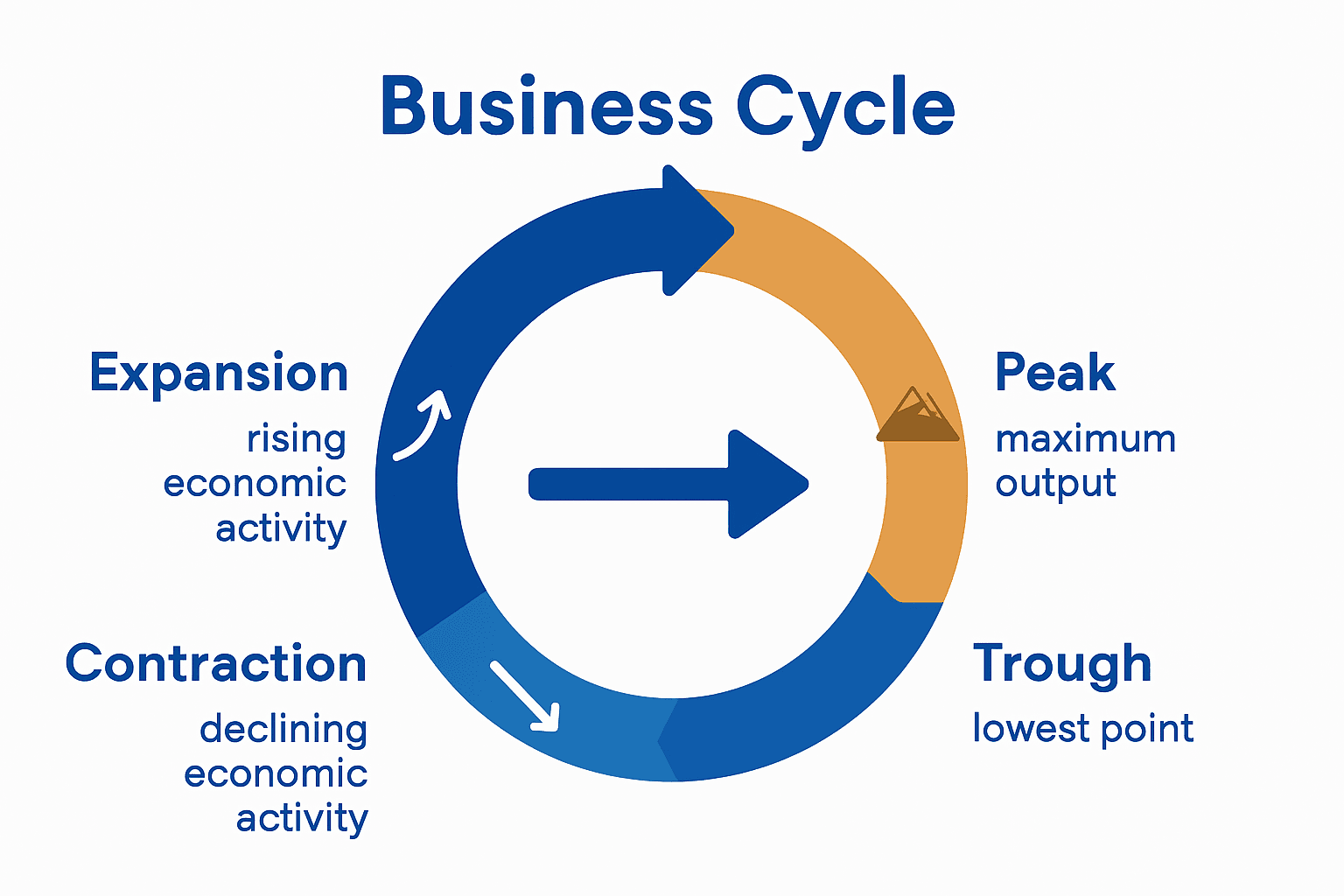Real Estate Market Cycles: Complete Breakdown

Did you know that home prices in Novi rose by 5.6 percent year-over-year while selling faster than ever before? Understanding why the market moves the way it does can mean the difference between a wise investment and a costly mistake. Real estate market cycles do not just shape local prices, they influence when buyers, sellers, and investors make their biggest decisions. Knowing these patterns helps you spot the best time to act and avoid risks in places like Oakland County.
Table of Contents
- Defining Real Estate Market Cycles
- The Four Phases of Market Cycles Explained
- Key Drivers Influencing Market Cycles
- Recognizing Local Trends in Oakland County
- Risks, Opportunities, and Investing Strategies
Key Takeaways
| Point | Details |
|---|---|
| Understanding Market Cycles | Real estate operates through four distinct phases: expansion, peak, contraction, and trough — each with unique characteristics that influence investment strategies. |
| Local Economic Influences | Population growth, employment levels, and local policies play critical roles in shaping real estate trends across Oakland County and nearby communities. |
| Investment Strategies | Successful investors adjust their approaches based on market conditions — focusing on acquisition and development during expansion and diversification or repositioning during contraction. |
| Continuous Monitoring | Tracking key indicators like housing inventory, days on market, and pricing trends enables professionals to identify profitable opportunities and mitigate potential risks. |
Defining Real Estate Market Cycles
Real estate market cycles are the predictable patterns of economic fluctuations that impact property values, sales volume, and investment opportunities within specific geographic regions. These cycles represent the natural ebb and flow of housing markets, characterized by distinct phases that reflect broader economic conditions, local demographic shifts, and real estate supply and demand dynamics.
Market cycles typically consist of four primary stages: expansion, peak, contraction, and trough. During the expansion phase, housing demand increases, property values rise, new construction accelerates, and investor confidence grows. This period often coincides with strong job markets, population growth, and favorable lending conditions in areas like Oakland County and metro Detroit.
The peak represents the market’s highest point, where property values reach their maximum before potential corrections occur. As selling a home in Michigan guide suggests, understanding these transitions helps homeowners and investors make strategic decisions about property acquisition, holding, or selling. Recognizing these cycles allows real estate professionals like Tom Gilliam to provide nuanced advice tailored to specific market conditions.
Each market cycle is unique, influenced by local economic factors, population trends, employment rates, and regional development. In Oakland County, for instance, cycles might be affected by automotive industry dynamics, technology sector growth, and migration patterns. Successful real estate strategies require continuous monitoring of these evolving market conditions to capitalize on emerging opportunities and mitigate potential risks.
The Four Phases of Market Cycles Explained
Real estate market cycles follow a predictable sequence of four distinct phases that help investors, homeowners, and realtor Tom Gilliam understand market dynamics and make strategic decisions. Each phase represents a unique economic environment with specific characteristics that impact property values, investment potential, and market behavior.
Here’s a summary of the four key phases in real estate market cycles:
| Phase | Market Characteristics | Typical Investor Strategy |
|---|---|---|
| Expansion | Rising demand Price appreciation New construction | Buy & hold Acquire rentals |
| Peak | Max property values Slowing growth Tight lending | Consider selling Reposition assets |
| Contraction | Falling demand Price stagnation or decline Longer listings | Adjust pricing Diversify holdings |
| Trough | Lowest prices Minimal new builds Low demand | Scout undervalued deals Prepare for recovery |
Expansion Phase: This initial stage represents robust economic growth and increasing housing demand. Key indicators include rising employment rates, population growth, and increased consumer confidence. In Oakland County, expansion might signal strong automotive or technology sector performance. Property values appreciate steadily, new construction accelerates, and investors see promising opportunities for appreciation and rental income.
Peak Phase: The market reaches its maximum potential during this phase. Property values stabilize at their highest point, with demand remaining strong but potentially showing early signs of saturation. Investors and homeowners experience peak valuations, though smart professionals recognize this as a potential signal to consider strategic selling or repositioning of real estate assets. Lending standards might become more stringent, and speculative investment could increase.
Contraction Phase: Economic conditions begin to cool, with housing demand decreasing and property value appreciation slowing or reversing. Factors like job market changes, reduced population growth, or broader economic challenges can trigger this phase. Investors and homeowners might experience reduced property values, longer market times, and more competitive selling environments. For Oakland County real estate, this could mean adjusting pricing strategies and being more flexible with market positioning.

Key Drivers Influencing Market Cycles
Market cycles are not random occurrences but complex interactions of multiple economic and demographic factors. Understanding these key drivers helps real estate professionals like Tom Gilliam anticipate market shifts and provide strategic guidance to clients in Oakland County and surrounding regions.
Demographic trends represent a critical driver of real estate market cycles. Population growth, age distribution, migration patterns, and household formation significantly impact housing demand. In Oakland County, factors like job market attractiveness, quality of school districts, and proximity to major metropolitan areas like Detroit influence population dynamics. Young professionals moving to technology corridors, families seeking top-tier suburban school districts, and retirees downsizing create nuanced market pressures that shape real estate trajectories.
Economic indicators play a fundamental role in market cycle progression. Employment rates, wage growth, interest rates, and local industry performance directly influence housing market conditions. The automotive and technology sectors in Michigan, for instance, can dramatically impact real estate values in Oakland County. When these industries experience growth, housing demand typically increases, driving property values and new construction. Conversely, economic downturns can trigger market contractions, reducing buyer confidence and slowing property appreciation.
Local government policies and infrastructure investments also significantly shape market cycles. Zoning regulations, tax structures, urban development plans, and public infrastructure projects can either stimulate or constrain real estate growth. In areas like Farmington Hills, Novi, and Northville, strategic municipal investments in transportation, education, and community development can attract new residents and investors, fundamentally altering local real estate market dynamics.
Recognizing Local Trends in Oakland County
Recognizing local real estate market trends requires a nuanced understanding of regional economic indicators, demographic shifts, and community-specific dynamics. In Oakland County, this means closely monitoring hyper-local factors that influence property values and market momentum across diverse communities like Farmington Hills, Novi, and Northville.
According to recent market data, Novi real estate reflects broader Oakland County trends. As of September 2025, home prices increased by 5.6% year-over-year, with a median sale price of $375,000 and properties selling after an average of 24 days on the market. These figures indicate a robust housing environment driven by strong local economic fundamentals, including proximity to technology corridors, excellent school districts, and strategic metropolitan location.
Submarket variations play a crucial role in understanding Oakland County’s real estate landscape. Different municipalities exhibit unique characteristics that impact housing demand. For instance, Farmington Hills might attract professional families seeking top-tier educational environments, while Novi could appeal to technology sector workers. Luxury markets in Bloomfield Hills demonstrate different appreciation rates compared to more affordable suburban neighborhoods, highlighting the importance of granular, neighborhood-specific analysis.

Successful real estate strategies in Oakland County require continuous monitoring of micro-market indicators. Factors like local employment rates, infrastructure developments, school district performance, and demographic migration patterns provide critical insights into potential market shifts. Real estate professionals must remain agile, interpreting these complex data points to guide clients through nuanced investment and homeownership decisions.
Risks, Opportunities, and Investing Strategies
Real estate investing demands a sophisticated approach to navigating market cycles, particularly in dynamic regions like Oakland County. Successful investors understand that strategic decision-making involves carefully balancing potential risks with emerging opportunities across different market phases.
Investment strategies can be categorically divided into proactive approaches tailored to specific market conditions. During expansion phases, how to sell inherited property becomes particularly relevant for investors looking to capitalize on rising property values. Opportunities include acquiring undervalued properties, investing in emerging neighborhoods like Novi and Farmington Hills, and leveraging rental property acquisitions during periods of steady appreciation.
Risk mitigation represents a critical component of real estate investment strategy. Sophisticated investors diversify their portfolios across different property types and locations within Oakland County. This might involve balancing residential investments between luxury markets in Bloomfield Hills, more affordable suburban areas, and potential growth corridors. Understanding local economic indicators, monitoring job market trends, and maintaining financial flexibility allows investors to pivot quickly during market transitions.
The most successful real estate investors adopt a long-term perspective, recognizing that market cycles are inherently dynamic. This means maintaining cash reserves, conducting thorough due diligence, and remaining adaptable to changing economic conditions. Strategies like value-add investments, strategic renovations, and carefully timed property acquisitions can help investors minimize downside risks while positioning themselves to capitalize on market opportunities across different cycle stages.
Navigate Every Real Estate Market Cycle with Confidence and Expert Guidance
Understanding the shifts between expansion, peak, contraction, and trough phases is essential to making the right move in Oakland County’s dynamic real estate market. Whether you are worried about timing your sale during a peak or looking for undervalued opportunities in a trough, these market cycles can feel overwhelming. Key challenges include deciding when to buy or sell, how to price your property effectively, and spotting local trends that directly affect your investment.
With over 20 years of experience, Tom Gilliam offers personalized support that turns these market complexities into clear, confident decisions. At Homes2MoveYou.com, you get more than listings—you gain a trusted partner familiar with Farmington Hills homes for sale and the unique market conditions throughout Oakland County, including Novi and Northville.

Take control of your real estate journey today and leverage expert insights tailored to every phase of the market cycle. Visit Homes2MoveYou.com now to connect with Tom Gilliam, one of the best realtors in Farmington Hills MI, and get started with proven strategies designed to maximize your success in any market condition.
Frequently Asked Questions
What are the phases of real estate market cycles?
Real estate market cycles primarily consist of four phases: expansion, peak, contraction, and trough. These phases reflect changes in property demand, value, and overall economic conditions.
How can I identify the expansion phase in the real estate market?
The expansion phase is characterized by rising demand, increasing property values, and new construction activities. Key indicators include strong job growth, increased consumer confidence, and low interest rates.
What strategies are recommended during the peak phase of the real estate market?
During the peak phase, it is advisable for investors to consider selling or repositioning their assets, as property values are at their highest. This is also a time to assess market saturation and tightening lending standards.
How can local economic factors influence real estate market cycles?
Local economic factors such as employment rates, industry performance, and demographic trends play a significant role in shaping real estate cycles. For instance, an increase in job opportunities in a region can lead to higher housing demand and property value appreciation.


